Abstract
The term “bound auxin” is herein used to describe auxin conjugates insoluble in organic solvents which dissolve indoleacetic acid (IAA) and its derivatives, but hydrolyzable by NaOH to release IAA. Bound auxin from pea stems was fractionated into water-soluble, water-insoluble/NaOH-hydrolyzable, and insoluble components. Formation of bound auxin commenced with 15 minutes of applying exogenous labeled IAA, and progressively increased in amount, relative to IAA uptake, over 6 hours. Formation was not restricted to any particular zone of the stem and occurred in both light- and dark-grown stems. A greater quantity of bound auxin was formed in light-grown stems, reaching 4.2 and 7.7%, of the IAA taken up, in the water-soluble and water-insoluble/NaOH-hydrolyzable fractions after 6 hours. The presence of sucrose, during either the IAA treatment or an aging pretreatment had no effect, though 6 hours aging did cause a subsequent increase in the water-insoluble fraction of the bound auxin. Bound auxin formation in light-grown stems was dependent on respiratory metabolism, being reduced by KCN. It was also reduced, compared to total uptake, by inhibitors of RNA, and protein synthesis (6-methylpurine and cycloheximide) but only when the inhibitors preceded auxin addition and were present for a 4-hour period. Addition of inhibitors following auxin had no effect, suggesting an early inductive effect of auxin on bound auxin formation. Inhibitors of cell elongation had no effect. Deoxyglucose, an inhibitor of glucan synthesis, had only a small effect on the water-soluble fraction. Bound auxin is an important auxin product in growing plants. Its function is unknown, but some possibilities are discussed.
Full text
PDF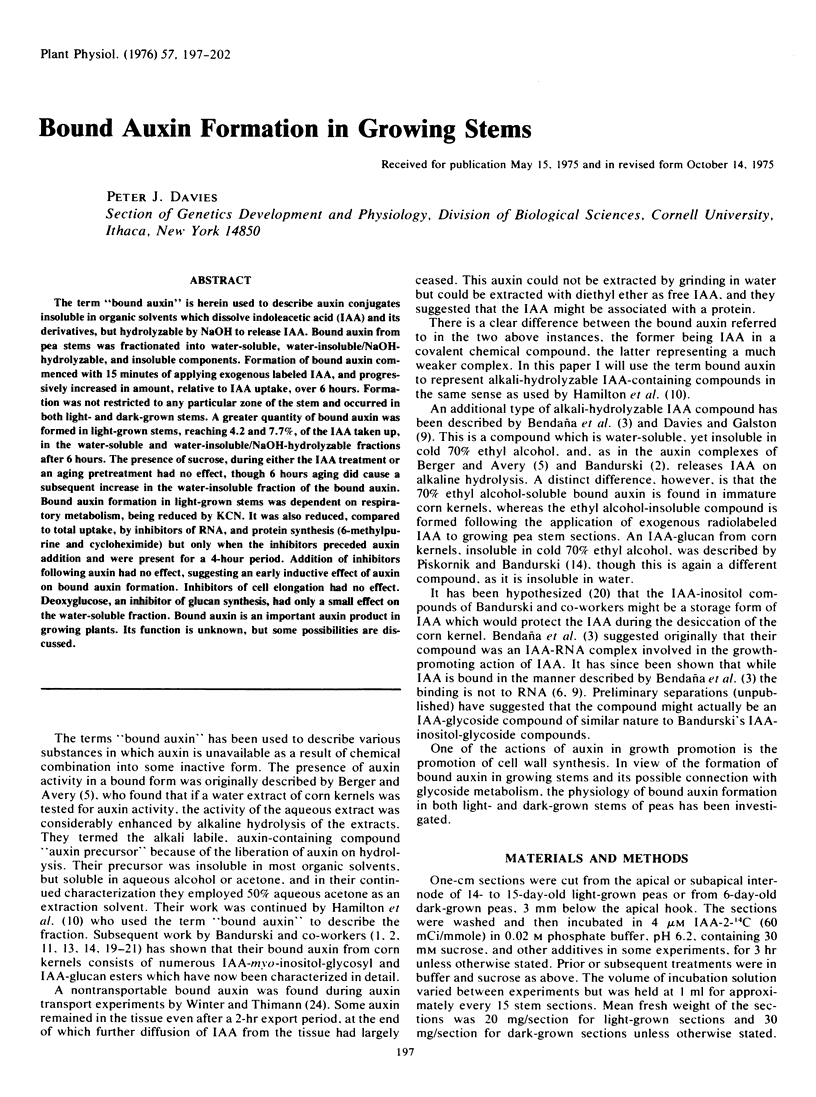
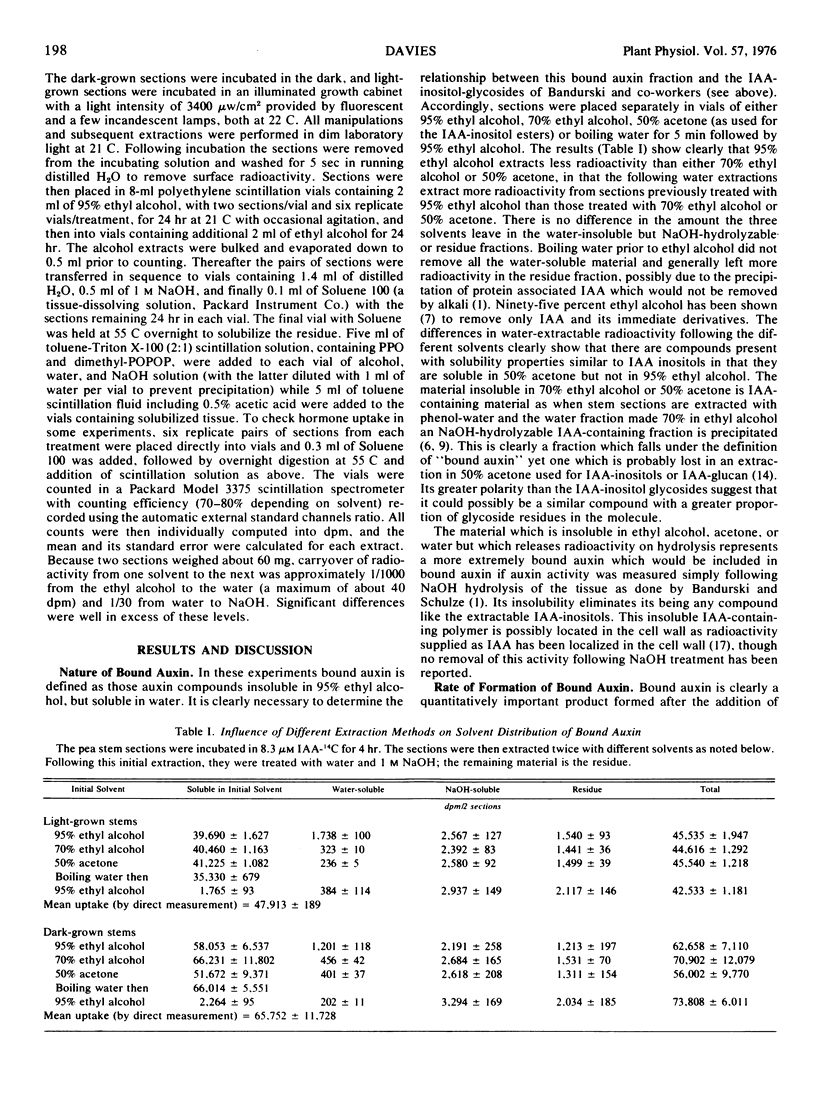
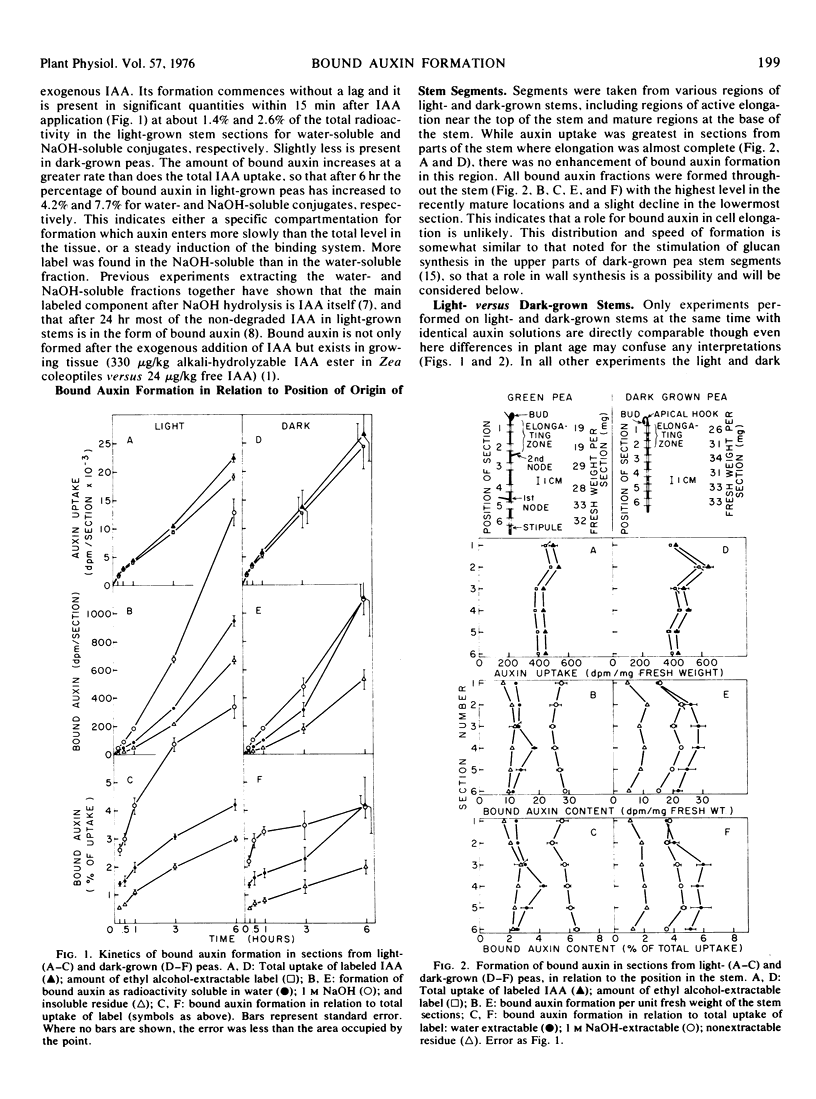
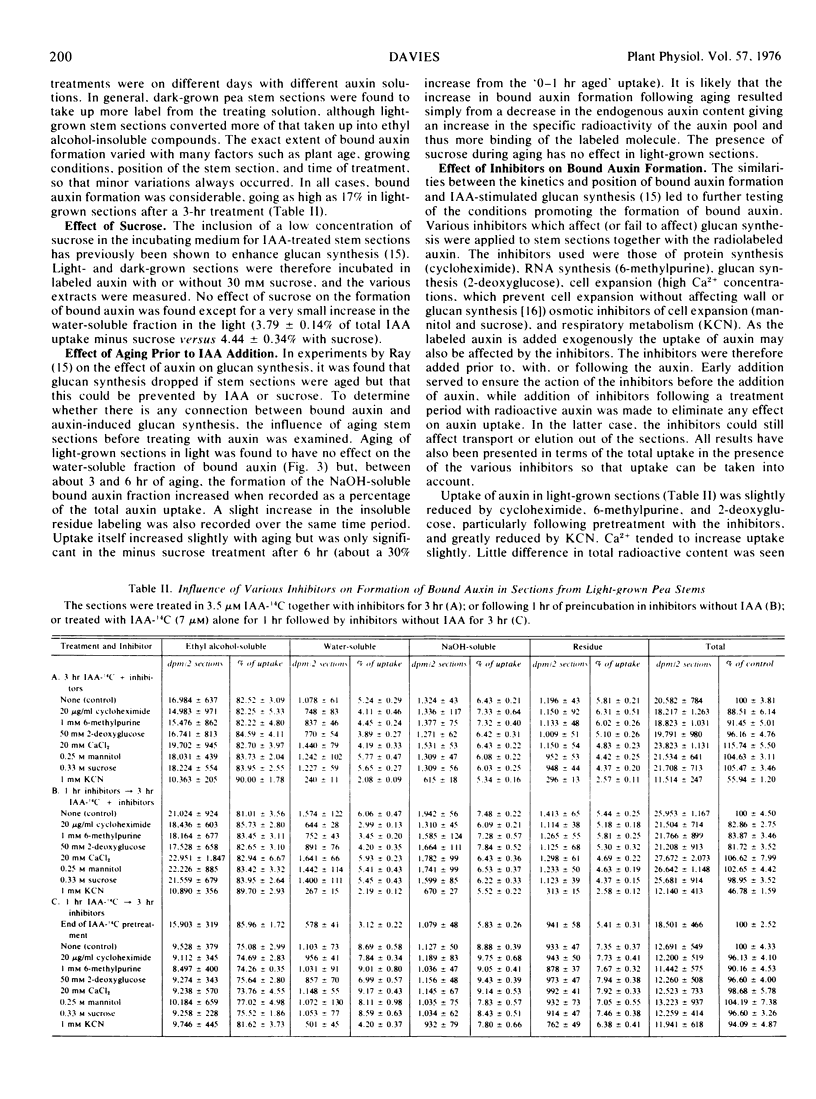
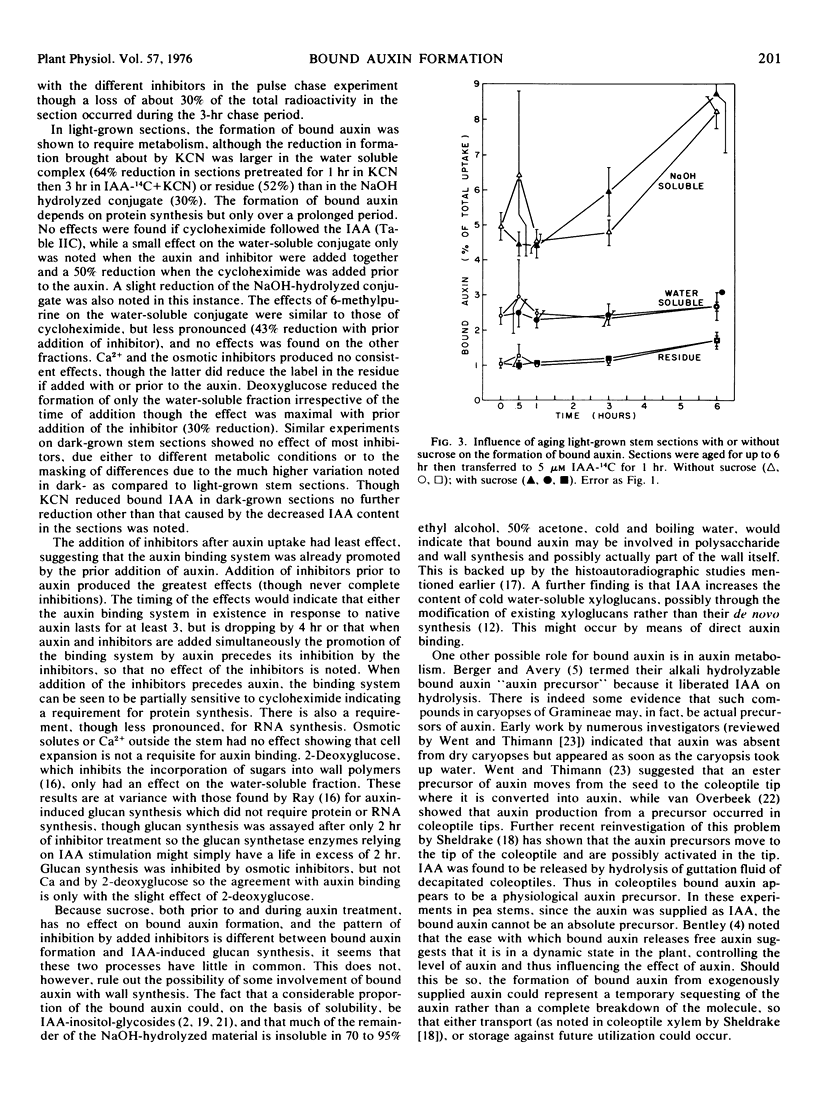
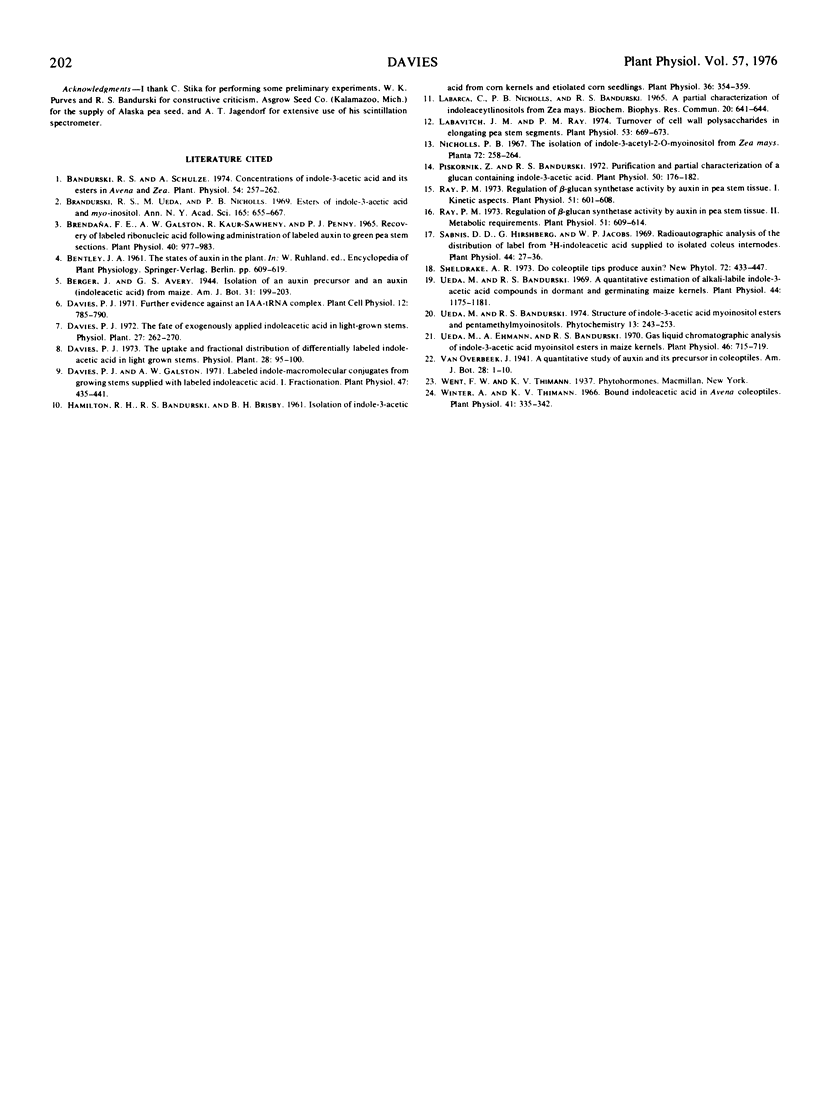
Selected References
These references are in PubMed. This may not be the complete list of references from this article.
- Bandurski R. S., Schulze A. Concentrations of Indole-3-acetic Acid and Its Esters in Avena and Zea. Plant Physiol. 1974 Sep;54(3):257–262. doi: 10.1104/pp.54.3.257. [DOI] [PMC free article] [PubMed] [Google Scholar]
- Bendaña F. E., Galston A. W., Kaur-Sawhney R., Penny P. J. Recovery of labeled ribonucleic acid following administration of labeled auxin to green pea stem sections. Plant Physiol. 1965 Nov;40(6):977–983. doi: 10.1104/pp.40.6.977. [DOI] [PMC free article] [PubMed] [Google Scholar]
- Davies P. J., Galston A. W. Labeled indole-macromolecular conjugates from growing stems supplied with labeled indoleacetic Acid : I. Fractionation. Plant Physiol. 1971 Mar;47(3):435–441. doi: 10.1104/pp.47.3.435. [DOI] [PMC free article] [PubMed] [Google Scholar]
- Hamilton R. H. Isolation of indole-3-acetic acid from corn kernels & etiolated corn seedlings. Plant Physiol. 1961 May;36(3):354–359. doi: 10.1104/pp.36.3.354. [DOI] [PMC free article] [PubMed] [Google Scholar]
- Labarca C., Nicholls P. B., Bandurski R. S. A partial characterization of indoleacetylinositols from ZEA mays. Biochem Biophys Res Commun. 1965 Sep 8;20(5):641–646. doi: 10.1016/0006-291x(65)90448-1. [DOI] [PubMed] [Google Scholar]
- Labavitch J. M., Ray P. M. Turnover of cell wall polysaccharides in elongating pea stem segments. Plant Physiol. 1974 May;53(5):669–673. doi: 10.1104/pp.53.5.669. [DOI] [PMC free article] [PubMed] [Google Scholar]
- Piskornik Z., Bandurski R. S. Purification and Partial Characterization of a Glucan Containing Indole-3-acetic Acid. Plant Physiol. 1972 Jul;50(1):176–182. doi: 10.1104/pp.50.1.176. [DOI] [PMC free article] [PubMed] [Google Scholar]
- Ray P. M. Regulation of beta-Glucan Synthetase Activity by Auxin in Pea Stem Tissue: I. Kinetic Aspects. Plant Physiol. 1973 Apr;51(4):601–608. doi: 10.1104/pp.51.4.601. [DOI] [PMC free article] [PubMed] [Google Scholar]
- Ray P. M. Regulation of beta-Glucan Synthetase Activity by Auxin in Pea Stem Tissue: II. Metabolic Requirements. Plant Physiol. 1973 Apr;51(4):609–614. doi: 10.1104/pp.51.4.609. [DOI] [PMC free article] [PubMed] [Google Scholar]
- Sabnis D. D., Hirshberg G., Jacobs W. P. Radioautographic analysis of the distribution of label from h-indoleacetic Acid supplied to isolated coleus internodes. Plant Physiol. 1969 Jan;44(1):27–36. doi: 10.1104/pp.44.1.27. [DOI] [PMC free article] [PubMed] [Google Scholar]
- Ueda M., Bandurski R. S. A Quantitative Estimation of Alkali-labile Indole-3-Acetic Acid Compounds in Dormant and Germinating Maize Kernels. Plant Physiol. 1969 Aug;44(8):1175–1181. doi: 10.1104/pp.44.8.1175. [DOI] [PMC free article] [PubMed] [Google Scholar]
- Ueda M., Ehmann A., Bandurski R. S. Gas-Liquid Chromatographic Analysis of Indole-3-acetic Acid Myoinositol Esters in Maize Kernels. Plant Physiol. 1970 Nov;46(5):715–719. doi: 10.1104/pp.46.5.715. [DOI] [PMC free article] [PubMed] [Google Scholar]
- Winter A., Thimann K. V. Bound indoleacetic Acid in Avena coleoptiles. Plant Physiol. 1966 Feb;41(2):335–342. doi: 10.1104/pp.41.2.335. [DOI] [PMC free article] [PubMed] [Google Scholar]


